
Louse is the common name for members of the order Phthiraptera, which contains nearly 5,000 species of wingless insect. Lice are obligate parasites, living externally on warm-blooded hosts which include every species of bird and mammal, except for monotremes, pangolins, and bats. Lice are vectors of diseases such as typhus.
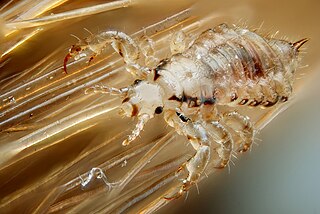
The head louse is an obligate ectoparasite of humans.
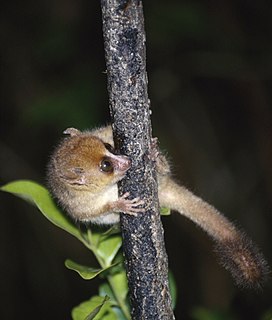
The brown mouse lemur is a small primate, and like the other mouse lemurs can only be found on the island of Madagascar. They are known also as the rufous mouse lemur, eastern rufous mouse lemur, red mouse lemur, or russet mouse lemur. Its dorsal side is brown or reddish-brown, while ventrally it is a whitish-grey.

This glossary of entomology describes terms used in the formal study of insect species by entomologists.
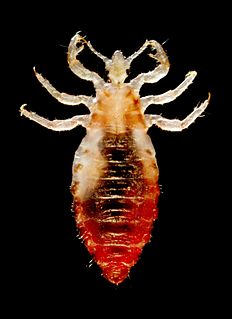
The body louse is a hematophagic ectoparasite louse that infests humans. It is one of three lice which infest humans, the other two being the head louse, and the crab louse or pubic louse.

Symbrenthia lilaea, the peninsular jester, is a species of nymphalid butterfly found in South Asia and Southeast Asia. It forms a superspecies with Symbrenthia hippoclus. There are numerous regional forms, and the taxonomy of the group is not well resolved.

Neptis jumbah, the chestnut-streaked sailer, is a species of nymphalid butterfly found in South Asia.

The reddish-gray mouse lemur also known as the gray-brown mouse lemur or rufous-gray mouse lemur, is found in Western Madagascar in the region around Beza Mahafaly Reserve, north to Lamboharana.
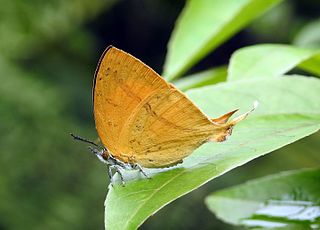
Loxura atymnus, the yamfly, is a species of lycaenid or blue butterfly found in Asia.

Macroglossum heliophila, the broad-bordered hummingbird hawkmoth, is a moth of the family Sphingidae. It was described by Jean Baptiste Boisduval in 1875. It is found from north-eastern Sikkim, India across southern China to Cheju Island, southern Japan, Taiwan and the Philippines and then south through Vietnam, Thailand, Malaysia and Indonesia to New Guinea and neighbouring islands. It is also known from Queensland, but doubt in Sri Lanka.
This glossary describes the terms used in formal descriptions of spiders; where applicable these terms are used in describing other arachnids.

Cebrionini is a tribe of click beetles from the family Elateridae; formerly ranked as a subfamily or family, they are now considered a tribe within the subfamily Elaterinae.

Trichodectes canis, also known as canine chewing louse, is a chewing louse found on domesticated dogs and wild canids throughout the world. T. canis is a well-known vector for the dog tapeworm, Dipylidium caninum. T. canis usually does not present any major problems to the host, however, can be very irritating in heavy infestations. In North America and most developed countries, T. canis infestation of domesticated dogs is very uncommon as long as they are properly cared for and healthy. Poorly taken care of dogs are more prone to getting a lice infestation.
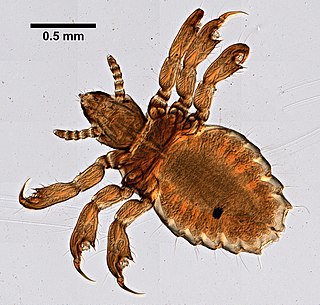
Haematopinus suis, the hog louse, is one of the largest members of the louse suborder Anoplura, which consists of sucking lice that commonly afflict a number of mammals. H. suis is found almost solely on the skin surface of swine, and take several blood meals a day from their hosts. The lice have large claws that enable them to grasp a hog's hair and move around its body. It is easily seen without magnification, being 5–6 millimetres (0.20–0.24 in) long. H. suis has a long, narrow head and long mouthparts adapted for sucking blood. It is the only louse found on swine. Louse infestation is relatively rare in the US, but a 2004 study found that about 14% of German swine farms had H. suis infestations. Due to the frequency of feeding, infected swine become severely irritated, often rubbing themselves to the point of injuring their skin and displacing body hair. Particularly afflicted hogs may become almost completely bald and, in young hogs, can arrest growth, a cause of concern for farmers.
Bovicola bovis is a cattle-biting louse found all over the world. It is a common pest of cattle of all types and sizes. They are one of many of the lice in the order Phthiraptera, but are divided from their blood sucking cousins in the sub-order Anoplura by the fact that they feed only by chewing. This makes B. bovis a member of the sub-order Mallophaga.
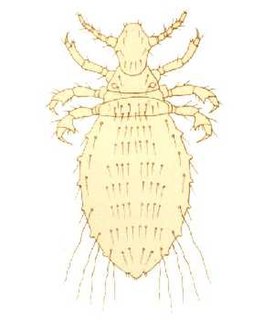
Solenopotes capillatus is known as the little blue cattle louse in the United States and the tubercle-bearing louse in Australia. This louse is the smallest of the sucking lice that occur on cattle and is a relatively immobile species. They are found all around the world in distribution but are restricted mainly to areas with domestic livestock. The little blue cattle louse is most often found on the head of its host, primarily the face and jaw region, but sporadically is found on other body parts. It is relatively immobile so typically will not relocate on its host's body. The louse is spread by direct contact and is considered an ectoparasite.
Lemurpediculus robbinsi is an ectoparasite of Crossley's dwarf lemur, Cheirogaleus crossleyi A. Grandidier, in Madagascar. Both sexes of the louse species are distinct from the two previously known species of Lemurpediculus, L. verruculosus (Ward) and L. petterorum Paulian.
Bucolus fourneti is a native Australian, small, hairy coccinellid beetle approximately 2.1-4.5 mm in diameter. It was described by Étienne Mulsant in 1850
Colpocephalum californici, the California condor louse, was a species of chewing louse which parasitized the critically endangered California condor. It became extinct when the remaining California condors were deloused and treated with pesticides during a captive breeding program.

Caenocholax fenyesi is a species of twisted-winged parasitic insects in the order Strepsiptera and family Myrmecolacidae. It has a sporadic distribution throughout North America, Central America, and South America. Chaenochlax brasiliensis is the only other named species in the genus.














